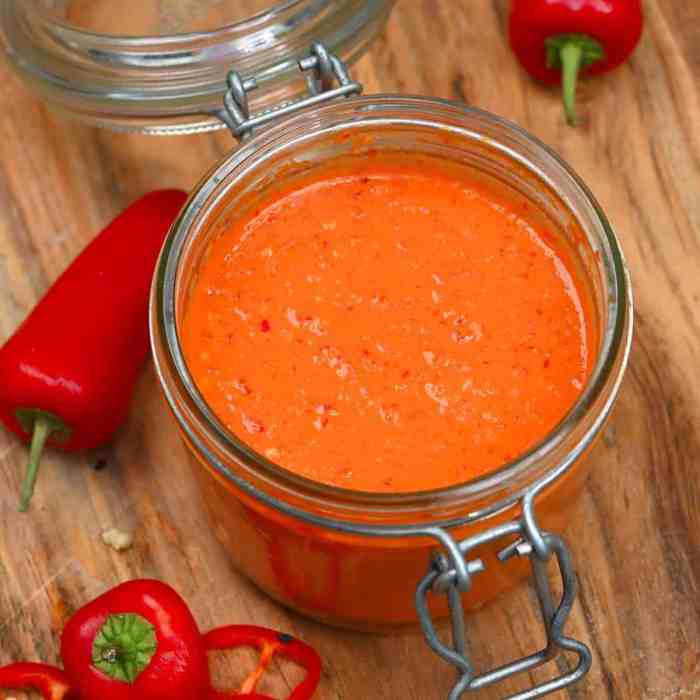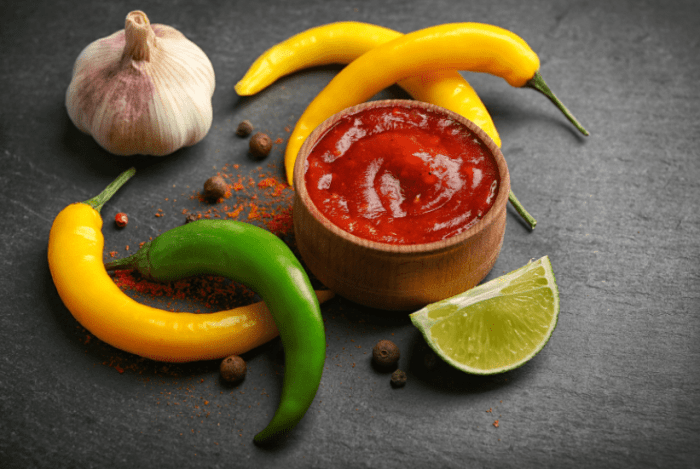Best Homemade Hot Sauce Recipe
The Allure of Homemade Hot Sauce: Best Homemade Hot Sauce Recipe
Best homemade hot sauce recipe – Crafting your own hot sauce is a rewarding culinary adventure, offering unparalleled control over flavor and heat. Unlike commercially produced sauces, homemade versions allow you to select the freshest ingredients, precisely tailoring the spice level and flavor profile to your personal preferences. The satisfaction of creating a unique, delicious condiment from scratch is unmatched.
Using fresh ingredients delivers a superior taste and texture compared to mass-produced hot sauces. The vibrant flavors of freshly harvested chili peppers, along with the nuanced notes of other ingredients, create a complexity impossible to replicate with processed ingredients. Freshness also ensures the highest nutritional value.
Hot sauce making boasts a rich history, with roots stretching back centuries to various cultures. Indigenous populations across the globe have long utilized chili peppers and other ingredients to create flavorful and spicy condiments. Modern hot sauce production has built upon these traditions, evolving into a diverse and vibrant culinary landscape.
Chili Pepper Selection and Preparation

Source: alphafoodie.com
Choosing the right chili peppers is paramount to achieving your desired heat and flavor. Consider the Scoville Heat Units (SHU), a measurement of pungency, to gauge the level of spiciness. Flavor profiles range from fruity and sweet to smoky and earthy, depending on the pepper variety. Availability varies seasonally, so plan your recipe accordingly.
Proper cleaning and preparation are essential. Thoroughly wash all vegetables and fruits before use. For onions and garlic, peel and chop to your desired size. Carrots can be peeled, diced, or julienned. Remember to always wear gloves when handling chili peppers to avoid skin irritation.
Wash your hands thoroughly after handling peppers, even with gloves on.
Safe handling of chili peppers is crucial to prevent skin irritation. Always wear gloves when handling them, and avoid touching your face or eyes. Wash your hands and any surfaces that come into contact with the peppers thoroughly.
| Pepper Name | Scoville Heat Units | Flavor Profile | Typical Uses |
|---|---|---|---|
| Jalapeño | 2,500 – 8,000 SHU | Fruity, slightly sweet | Salsa, tacos, general use |
| Serrano | 10,000 – 23,000 SHU | Slightly bitter, grassy | Salsas, hot sauces, marinades |
| Habanero | 100,000 – 350,000 SHU | Fruity, citrusy, floral | Hot sauces, Caribbean cuisine |
| Scotch Bonnet | 100,000 – 350,000 SHU | Sweet, fruity, slightly smoky | Jerk seasoning, hot sauces |
Hot Sauce Recipe Variations

Source: thecuriouschickpea.com
Crafting the best homemade hot sauce involves careful consideration of pepper selection and balancing flavors. For a slightly sweeter kick, consider incorporating elements found in great barbecue sauces; you might find inspiration in these barbecue sauce recipes from scratch , which often feature delicious combinations of smoky and sweet. Ultimately, the perfect hot sauce recipe is a testament to personal preference, allowing for endless experimentation and delicious results.
This section presents three distinct hot sauce recipes, each showcasing unique flavor profiles and textures. The vinegar-based recipe provides a classic tangy profile, the oil-based recipe offers a smooth, rich consistency, and the fermented recipe develops complex flavors over time.
Vinegar-Based Hot Sauce

Source: gardenfrontier.com
Ingredients: 1 lb jalapeños, 1 cup white vinegar, 1/2 cup water, 1 tsp salt, 1 clove garlic (minced).
Instructions: Combine all ingredients in a saucepan. Simmer for 15 minutes. Blend until smooth. Strain if desired. Bottle and store.
Oil-Based Hot Sauce, Best homemade hot sauce recipe
Ingredients: 1 lb habaneros, 1 cup olive oil, 1/4 cup lime juice, 1 tsp salt, 1/2 tsp cumin.
Instructions: Roast habaneros until blistered. Blend with remaining ingredients until smooth. Bottle and store in the refrigerator.
Fermented Hot Sauce
Ingredients: 1 lb serrano peppers, 1/2 cup sea salt, 1 cup filtered water, 1/4 cup apple cider vinegar, 2 cloves garlic.
Instructions: Combine peppers and salt in a jar. Let sit for 24 hours. Add water and garlic. Ferment for 2-4 weeks. Blend with apple cider vinegar.Bottle and store.
The vinegar-based sauce provides a sharp, acidic bite. The oil-based sauce offers a smoother, richer texture and a more mellow heat. The fermented sauce boasts complex, umami notes developed through the fermentation process. Each recipe delivers a distinct textural experience.
Cooking and Processing
Cooking hot sauce typically involves simmering the ingredients to soften them and develop their flavors. Blending creates a smooth or chunky consistency, depending on your preference. Sterilizing jars and bottles is crucial for safe storage. This can be achieved by boiling them in water for 10-15 minutes.
Canning or freezing are effective methods for long-term preservation. Canning requires proper equipment and techniques to ensure safety. Freezing preserves the flavor and texture well, although some separation might occur.
Presentation is key. Consider using attractive bottles or jars and adding custom labels to showcase your homemade creation.
Storage and Shelf Life
Proper storage significantly impacts shelf life. Refrigeration is recommended for all homemade hot sauces to maintain quality and prevent spoilage. Dark, cool places are preferable to reduce light exposure.
Signs of spoilage include mold growth, unusual discoloration, or off-odors. Discard any sauce exhibiting these signs.
To extend shelf life, ensure proper sterilization and airtight storage. Refrigeration is crucial for non-canned sauces.
Serving Suggestions and Pairings
The versatility of homemade hot sauce allows for a wide range of pairings and serving suggestions. The heat level and flavor profile guide the ideal food combinations. Experimentation is key to discovering your favorite pairings.
| Recipe Name | Suggested Food Pairing | Reason for Pairing | Serving Suggestion |
|---|---|---|---|
| Vinegar-Based | Tacos, eggs | Acidity complements richness | Drizzle over food |
| Oil-Based | Grilled meats, roasted vegetables | Oil adds richness, heat mellows | Spoon over food |
| Fermented | Stews, soups | Umami adds depth of flavor | Add during cooking |
Visual Guide to Chili Peppers
- Jalapeño: Generally green, sometimes red when ripe; oblong shape; smooth skin; moderate heat.
- Serrano: Bright green or red; conical shape; smooth skin; significantly hotter than jalapeño.
- Habanero: Variety of colors (orange, red, yellow); lantern-shaped; bumpy skin; extremely hot.
- Scotch Bonnet: Bright orange or red; heart-shaped; bumpy skin; extremely hot, fruity flavor.
- Ghost Pepper (Bhut Jolokia): Reddish-brown; wrinkled, bumpy skin; extremely hot; intense flavor.
User Queries
How long does homemade hot sauce last?
Properly stored, homemade hot sauce can last for 6 months to a year or even longer. Refrigeration is crucial.
Can I adjust the heat level in the recipes?
Absolutely! The amount of chili peppers used directly impacts the heat. Start with less and add more to your preference.
What should I do if my hot sauce starts to mold?
Discard any hot sauce showing signs of mold. Mold indicates spoilage and consumption could be harmful.
Are there vegan hot sauce options?
Yes! All the recipes can be easily adapted to be vegan by omitting any non-vegan ingredients.





















